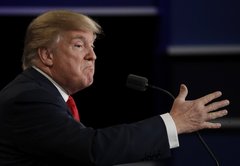Build a wall, and make Mexico pay for it
Donald Trump
"I would build a great wall, and nobody builds walls better than me, believe me, and I’ll build them very inexpensively. I will build a great great wall on our southern border and I’ll have Mexico pay for that wall."
Trump-O-Meter

Promise Broken

